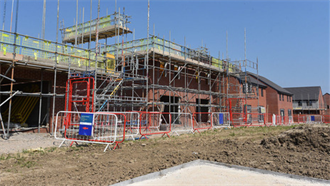A new approach is required to deal with post-pandemic non-performing exposures brought on by the crisis, so that the long-term economic value of underlying assets is maximised.
During every economic downturn, bank and financial services companies are experiencing a large number of defaults in their loan books. Unlike financial crises’ over past decades, there is a fundamental difference by the financial distress caused during this pandemic. Stakeholders need to consider different approaches to handling the defaults on loan books and debt securities as well as challenging real estate exposure.
Past crises
In the previous crises’, many financial institutions sold a large part of their non- and sub-performing loan (NPL & SPL) book as well as assets, together Non-Performing Exposure (NPE), in the secondary market as they shifted this exposure to unregulated private equity investors and other buyers, who made a sizeable profit on the recovery of the assets after acquiring these at large discounts. NPL’s were regarded as “trading” loans; bought at large discounts by investors with recovery through either threatening foreclosure, offering discounted payoffs, refinancing at lower rates, sale via auctions and light lease up measures to sell as yielding assets.
Many financial institutions did not digitize the data and were struggling with disclosure of data according to their jurisdiction’s privacy laws. Legal and financial advisors helped unravel these challenges. More sophisticated financial advisors came up with various scenarios such as creating securitisation structures to avoid true sales and then shifting first loss pieces to financial investors, tranching up loans into junior and senior debt and creating asset management companies to tackle the balance sheet treatment for the financial institutions that had NPE. The examples below removed pressure from financial institutions with NPE and enabled post crises lending to businesses and households.
European responses
Italian NPL Securitisations have been ongoing ever since there was a large surge in NPLs in Italy in the `90`s through the securitisation scheme (law 130) implemented in 1999. The Italian government guaranteed senior notes issued in NPL securitisations through its GACS scheme, which allowed for around €75bn of transactions since implementation in 2016. Currently large Italian banks hold NPLs in excess of target levels and above the 5% healthy limit ratio suggested by the European Banking Authority (EBA).
Germany adopted similar structures by creating so called “bad banks” and issuing AAA rated bonds backed by the German government to support the transfer from two financial institutions with Non- Performing Exposure (NPE) of €180 bn to FMS (former Hypo Real Estate exposure) and €155 bn to EAA (former WestLB exposure) at book value.
Similar structures between 2009 to 2012 were implemented in Ireland by NAMA and in Spain by Sareb, which were successful at managing non-performing exposure.
As consistently sub inflationary economic growth rates across Europe were the new normal pre pandemic and low interest rates formed part of the ecosystem, asset prices rose to new highs. Some economies across Europe were already in uncharted negative base rate territory.
Real estate, which tends to hold most value as security in NPE’s, is also challenged, as transforming some commercial real estate asset classes is vital to recovering underlying real estate value. Spreads between prime real estate yields and government bond yields are at the highest since the last 20 years at around 400 basis points, making the real estate asset class attractive.
While we emerge from Europe-wide lockdowns, furlough systems, payment holidays on loans and tax and quantitative easing in 2021, European economies will contract with rising unemployment rates and shifts in demand that the population has not seen for more than a century.
The new crisis
Banks and financial institutions will be impacted by potential defaults, impaired assets and increased risk exposure, likely larger than in any previous crises. Initial estimates by Andrea Enria, current chairman of the banking supervisory board of the ECB, suggest a €1.4 trn surge of NPLs post pandemic. In the Global Financial Crises in Q2 2009, the NPL level was at around €443 bn.
NPE size is never very precise as NPE classification methods vary by country, depending on ageing, partial payments and when loans officially become risk exposure requiring loan loss provisions. Data on NPLs is the past has also been difficult to manage as many institutions had not digitised or correctly recorded exposure. This problem is more pertinent to loans that were originated before the millennium, which in some countries have long durations and judicial lead times to default.
The EBA initiatives since 2014 have led to harmonisation of NPL classifications, where all loans are considered NPE in default if unpaid for 90 days, which combined with the Basel approach of Unlikely to Pay (UtP) is a more standardised framework to classify NPE. IFRS 9 permitted financial institutions of all sizes to use their own models to determine their Expected Credit Losses (ECL). ECL’s are calculated as a multiplication of the Exposure at Default (EAD),the Probability of Default (PD) and the Loss Given at Default (LGD) The EBA 2018b provides guidelines that apply from January 2021 for PD and LGD. However, financial institutions can use historical or their own data to come up with ECL and provisioning.
Financial institutions are recommended to increase provisioning for all loans originated after 26 April 2019 as of January 2021 under the Prudential Backstop mechanism. Increased standardisation will accelerate losses on balance sheet for financial institutions and put increased pressure on Risk Weighted Assets that effect Tier 1 Capital. Consequently, there will be an increased motivation to sell NPE through secondary markets. There is a distinction between provisioning unsecured vs secured assets, as unsecured loans provision within 2 years and secured loans ramps up over 7 years.
Many financial institutions are better capitalised than in the last crises with Tier 1 ratios at 16.51 % vs around 8% at the end of 2008. In a report published by McKinsey in July 2020, the Tier 1 Capital for Germany, France, Spain and Italy under milder post pandemic recovery scenarios were predicted to fall between 3% and 5.5%, whilst in a longer recovery this may result in a 5% to 7.5% decline resulting in immediate stress for some European banks.
Every financial institution requires a roadmap to allows a healthy NPL ratio between 3-5% of total exposure. Although current statistics published by the ECB suggest a steady decline in NPE from around 7.5% of loans in Q2 2015 to below 3% in Q2 2020, these statistics are usually lagging and do not include effects of the pandemic, government support schemes, furloughing, moratoria and also the Prudential Backstop and the ECL standardisation, effective January 2021.
The pandemic has created a big shift in real estate values, with changing work patterns influencing part of the shift as well as the acceleration of online shopping. Logistics assets are high in demand, whilst retail assets are out of favour. Outer town residential is experiencing a renewed boom, as many office workers are willing to take on increased commute times with less frequent visits to inner city offices.
Fixing the challenges of inner city commercial real estate and the change in urbanisation will be key to unlocking value behind NPE`s. Planning and Zoning changes require time to modify usage of buildings to suit changed working, commuting and tourism habits. As an example, significantly reduced business travel will reduce overnight stays making some hotels built for business travellers unviable. The footprint for large infrastructure assets, such as airports and train stations. Finding alternative real estate applications will take time.
New approach
The European and national governing bodies should consider a viable alternative to selling NPE at discount to par value to financial investors. This route leaves financial institutions with large impairments and unable to fund healthy and viable enterprises and households, that are required to support GDP.
A new approach is required to deal with post pandemic NPE that requires a more detailed view on each asset class involved to maximise long term economic value:
1. Transfer all commercial real estate backed NPE to real estate focused asset management companies (REAMC’s), who under direction of local ministries of finance and ECB supervision could focus on restructuring, repositioning and repurposing underlying real estate. REAMC’S would then do a better service to taxpayers by recovering the maximum value over a determined timeframe of 5 to 7 years. before selling to institutional long term yield searching investors
2. NPE backed by owner occupied residential real estate could undergo separate restructuring within the financial institutions with modified payment plans or consensual single asset sales.
3. Corporate real estate backed as well as unsecured SME backed NPE would require a more analytical approach to analyse business plan viability for each enterprise going forward.
4. Unsecured loans not connected to the above three categories could be added directly into the secondary market by financial institutions in portfolio sales, as extracting value for these loans are more suited for large recovery platforms.
The Ministries of Finance in each European jurisdiction will require coordination and oversight in order to ensure that financial institutions report NPE according to the new standardised approaches. Interventions for NPE falling in category 1 and 3 could be centralised in managing and disposing of commercial real estate to international institutional investors. The ECB, EBRD and EU are all institutions that could act as stakeholders to coordinate and supervise such guidelines and enable capitalisation through bond issuance and interventions.
The above approach seems ambitious, however, transferring at long term economic value and allowing recovery would limit writedowns of Tier 1 capital, leaving many banks healthy enough to lend to enterprises and households, who require funding to recover post pandemic.
Author: Dilip Awtani is founder of investment advisory firm, Tact Capital. He is a former head of GE Capital Distressed Investments and has also worked for Colony Capital, Houlihan Lokey, Jahama, JP Morgan, Commerzbank, WestLB and Euromobiliare


































